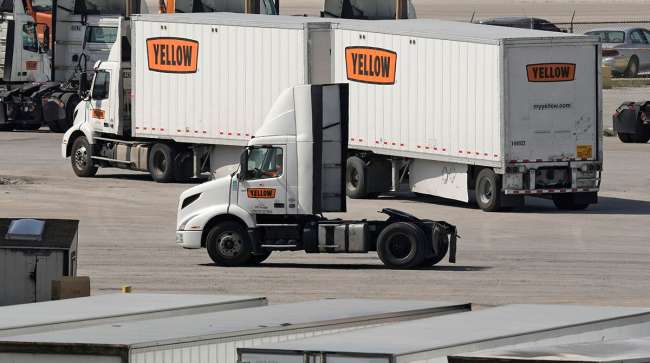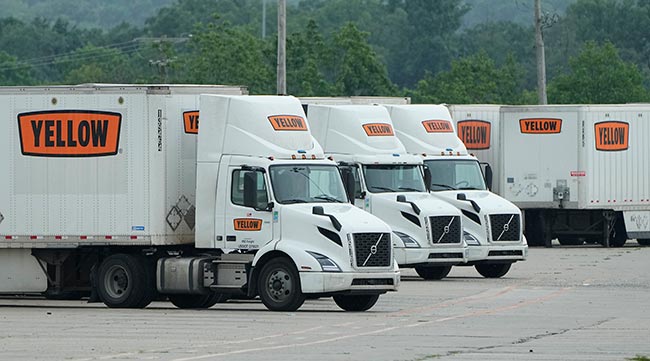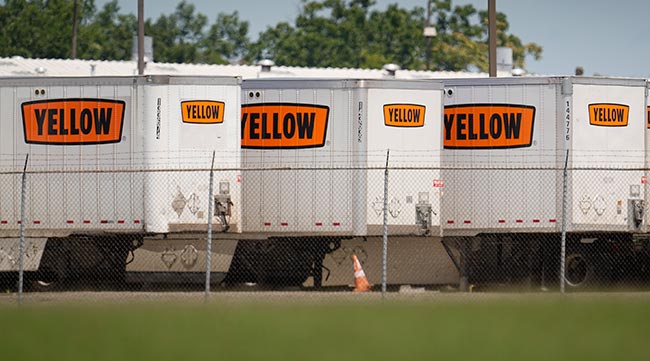Senior Reporter
Yellow Files for Chapter 11 Bankruptcy

[Stay on top of transportation news: Get TTNews in your inbox.]
Yellow Corp. on Aug. 7 announced it was seeking Chapter 11 bankruptcy protection and entering into an agreement that would secure sufficient financing for the nearly 100-year-old company to wind down operations.
The company submitted the filing in federal court in Wilmington, Del. Under terms of the arrangement, Yellow said it would enter into a “debtor-in-possession” agreement under which it would be provided with “needed liquidity which will be used to support the businesses throughout the marketing and sale process, including payment of certain pre-petition wages.” In particular, it asked the bankruptcy court for permission to make payments, including for employee wages and benefits, taxes and certain vendors essential to its businesses.
According to Yellow’s lead bankruptcy attorney, three entities were set to compete to provide that liquidity. Investment giant Apollo Global Management, hedge fund MFN Partners and Yellow’s less-than-truckload rival Estes Express Lines all were in the running to fund the bankruptcy, said Kirkland & Ellis Partner Patrick Nash, during an Aug. 9 hearing before U.S. Bankruptcy Judge Craig Goldblatt.
According to a Bloomberg report, the proposals by MFN Partners (Yellow’s biggest shareholder) and Estes had more favorable financial terms than Apollo’s. Estes declined to comment on the report when contacted by Transport Topics.
Per Bloomberg, Estes offered Yellow $230 million compared with the $142.5 million Apollo offered and at a better interest rate, Nash told the judge. Estes’ loan would offer a 15% interest rate, compared with 17% interest due Apollo.
The company will seek to restructure its estimated $1.5 billion in debt, which includes more than $700 million owed to the U.S. government. Per the conditions of that loan, taxpayers now hold 30% of the company’s stock, which has plunged in value as the company’s finances unraveled.
The company’s operation includes 300 facilities, a fleet of more than 12,500 trucks and 42,000 trailers.
“It is with profound disappointment that Yellow announces that it is closing after nearly 100 years in business,” Yellow CEO Darren Hawkins said in the statement. “Today, it is not common for someone to work at one company for 20, 30, or even 40 years, yet many at Yellow did. For generations, Yellow provided hundreds of thousands of Americans with solid, good-paying jobs and fulfilling careers.”
The closure will leave as many as 30,000 people out of work, including 22,000 workers represented by the International Brotherhood of Teamsters union.
The company in its statement placed considerable blame for the bankruptcy on the union.
“All workers and employers should take note of our experience with the International Brotherhood of Teamsters and worry,” said Hawkins. “We faced nine months of union intransigence, bullying and deliberately destructive tactics. A company has the right to manage its own operations, but as we have experienced, IBT leadership was able to halt our business plan, literally driving our company out of business, despite every effort to work with them.”
It’s with profound disappointment that we are closing after nearly 100 years in business. Today, it’s not common for someone to work at a company for 20,30, 40 years, but many at Yellow did. For generations. We provided solid, good-paying jobs and fulfilling careers. pic.twitter.com/yLPC4BBKah
— Yellow (@Yellow_Trucking) August 7, 2023
The Teamsters in an Aug. 7 statement said its legal and economic teams are “closely following Yellow’s moves throughout bankruptcy proceedings,” and the group said it would “denounce any attempt by the company to evade its financial obligations through legal maneuvers.”
Teamsters President Sean O’Brien said, “Teamster families sacrificed billions of dollars in wages, benefits, and retirement security to rescue Yellow. This is a reminder of why workers’ ability to organize and collectively bargain is so crucial to protecting and creating good jobs in America.”
A nearly $730 million loan Yellow received as part of the government’s pandemic-related relief for businesses enabled the carrier to add new equipment and spur its operations. However, Yellow said labor negotiations with IBT stalled its rehabilitation efforts, particularly as it related to the carrier’s “One Yellow” revitalization plan. That effort had early success, as the company reorganized much of its West Coast operation and set in motion plans to close some terminals in the Midwest and East Coast. However, IBT said the changes were outside the scope of its existing contract, and an effort to reopen the union contract a year early and negotiate a new, multiyear deal failed amid lawsuits and an increasing level of acrimony.
“We tried everything to work with IBT leadership and did all we could to save employees’ jobs,” Hawkins said in the Aug. 7 announcement. “We are crushed by today’s announcement, yet we are grateful to our tens of thousands of employees who took care of our customers until the end.”

Yellow Corp. trucks and trailers at a YRC Freight facility July 28 in Richfield, Ohio. (Sue Ogrocki/Associated Press)
Industry watchers recognized the challenges Yellow faced.
“The company was making incredible progress on its plan to reduce its cost structure and get back to profitability, but without an agreement with the union there was no possibility of the company continuing with the cost cuts and the consolidation plan, and there was no way to renegotiate the debt that was coming in 2024,” said Stifel research director for transportation Bruce Chan in the days following the company’s July 31 closure. “It was a slow bleed, but there was a sequence of events that really drove the timing that unfolded recently.”
Among those recent challenges was a threatened benefits-related strike by union workers in late July that was staved off at the 11th hour.
“Yellow’s customers were nervous they were going to have a strike with the Teamsters, and they were worried whether the company was going to make its financial obligations [and] started pulling their freight from Yellow and sent the business to other LTL carriers,” said Michigan State University business professor Jason Miller. “It was a catastrophic failure, and they lost a substantial amount of freight, especially with the cash position they were in.”

Yellow trailers at a YRC Freight facility July 31 in Nashville. (George Walker IV/Associated Press)
The decline in revenue was illustrated by earnings released by the company Aug. 9. Yellow’s operating revenue in the second quarter of 2023 totaled $1.127 billion, compared with $1.424 billion in the year-ago period. The company posted a loss of $14.7 million in the most recent three months, compared with a profit of $60 million in the year-ago period. As of June 30, Yellow had cash and cash equivalents of $112.8 million, less than half the $235.1 million it had in the bank six months earlier.
Paul Bingham, director of transportation consulting with S&P Global Market Intelligence, said the U.S. Treasury and other creditors will likely end up taking a significant hit. “Whatever the U.S. government owned — 30% of the stock — that goes to zero in bankruptcy court. The shareholders get zero,” he said. “There are not enough residual assets left where anybody but some higher-rated debt holders will get any money out of this.” Yellow has primarily made interest payments on the federal loan.
Miller said the government could recoup some money from the sale of equipment Yellow purchased with its federal loan. “I don’t think the U.S. government needs a trucking company. Yellow has a lot of trucks,” he said. Miller also noted that the company’s efforts to renegotiate with other creditors was stymied by rising interest rates and tightening credit.
Yellow in the 2000s made a series of high-profile, high-dollar acquisitions that expanded its scope while also increasing its debt load. The company in 2003 bought trucking rival Roadway Corp. for over $1 billion — a deal that would pave the way for a new identity as YRC Worldwide. It grew again in 2005 with the purchase of USF Corp. for $1.37 billion.
Yellow found itself in dire financial straits as far back as 2009 after posting nearly $2 billion in losses over five fiscal quarters. Leadership at the time convinced bondholders to swap their debt for equity in the company. But over the past several years, the company’s quarterly results have shown continued financial losses.
Now, the company’s thousands are out of work during what analysts are calling a freight recession in trucking.
American Trucking Associations has created a website to assist former Yellow employees with finding new jobs in the trucking industry.
“Our message to former Yellow employees is that we want them to remain a part of the industry that they have done so much to build and strengthen,” ATA President Chris Spear said.
Yellow’s closure is a substantial blow to America’s economy and the company’s 30,000 hardworking employees and their families in all 50 states. pic.twitter.com/IHNqszN7iI
— American Trucking (@TRUCKINGdotORG) August 1, 2023
Yellow Corp. ranks No.13 on the Transport Topics Top 100 list of the largest for-hire carriers in North America and No. 3 on the TT list of the largest less-than-truckload carriers.
Want more news? Listen to today's daily briefing below or go here for more info:




